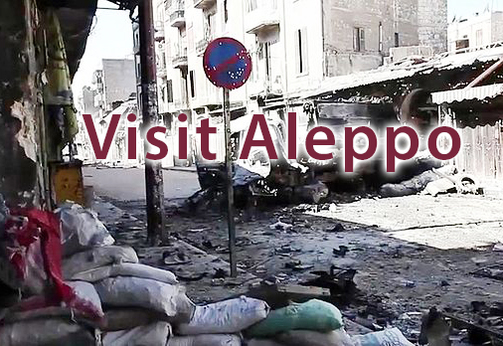The Syrian Ministry of Tourism has released a pleasant promotional video for Aleppo, aimed at encouraging travelers to visit one of Syria’s most historic cities. The one-minute piece, entitled “Aleppo . . . Will of Life,” features sweeping shots of the city’s unique architecture, lush parks, and other landmarks. The enticing visuals play over a familiar music bed--the theme song for HBO’s Game of Thrones.
The creatively choreographed clips could cause one to give a visit to Aleppo serious consideration; that is, if one is like former governor of New Mexico and Libertarian presidential candidate Gary Johnson who infamously asked in a television interview what Aleppo was.
With a population of over 1.6 million and an area of about 70 square miles (about twice as big as Paris), (5) Aleppo is Syria’s largest city. It was first settled around 5000 BC and has been recognized as a UNCESCO World Heritage site; although, most of the ancient architecture that earned it that designation now lies in ruins thanks to a civil war that has ravaged Syria and the city for about five years.
Because of the fighting, Aleppo has literally become a city torn in two. Under control of government forces loyal to President Bashar al-Assad, the western half has retained some semblance of normalcy. That’s the part of the city that the Syrian Board of Tourism is promoting. However, the eastern half of the city, controlled by rebels, Kurds, and ISIS, presents an entirely different picture. “Entire blocks of buildings are reduced to rubble” causing much of eastern Aleppo to look like “an obliterated wasteland” where people struggle to find daily necessities for survival. In short, “It is a nightmare.”
As a result of the extremely volatile situation in Aleppo and other parts of the country, many nations (e.g., the UK, Australia) have advised their citizens not to travel to Syria. Americans have been similarly advised:
“The Department of State continues to warn U.S. citizens against all travel to Syria and strongly recommends that U.S. citizens remaining in Syria depart immediately. The security situation remains dangerous and unpredictable. Violent conflict between government and armed anti-government groups continues throughout the country. There is a serious risk for kidnappings, bombings, murder, and terrorism.”
So, why is Syria inviting outsiders into this dangerous environment? An obvious answer would be that Syria is just trying to do what many other countries do—encourage tourism, which is an important source of income, especially for nations that lack other significant industry. On the other hand, advertising Aleppo and other Syrian cities could be an attempt by the Assad regime to persuade a world concerned about the increasing loss of life and refugees that the country has everything under control: ‘All’s good here—see how peaceful it looks.’
Whatever the motivation for the promotion, it’s unfortunately likely that some imprudent people will accept the tourism invitation and, defying sound judgment and the many state-sponsored travel advisories, venture into the war-torn land. Past indiscretions of travelers to Iran and North Korea offer some support for this speculation.
It doesn’t help that the Aleppo video is decidedly deceptive. Yes, advertising is advocacy, and advertisers are expected to put their best foot forward, but not at the expense of truthfulness. It’s one thing to portray a product in a positive light; it’s another thing to obscure the product’s real nature. Some have suggested that the Game of Thrones theme is an eerily appropriate choice for the Aleppo ad, given that “the show's fictional world of Westeros is a violent place engaged in its own bloody civil war.” The music, then, might be the only part of the video that isn’t misleading.
Thankfully, most people are rational and will reject Syria’s tourism invitation. Still, there are those few foolhardy folks who don’t need any extra encouragement to put themselves and others in harm’s way. For these reasons, advertising Aleppo as a travel destination must be considered “Mindless Marketing.”
Learn more about the Mindful Matrix and Mindful Meter.
Check out Mindful Marketing Ads and Vote your Mind!




 RSS Feed
RSS Feed